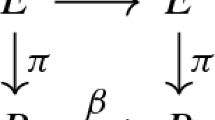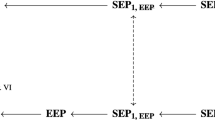Abstract
A popular method for comparing the structures of mathematical objects, which I call the ‘subset approach’, says that X has more structure than Y just in case X’s automorphisms form a proper subset of Y’s automorphisms. This approach is attractive, in part, because it seems to yield the right results in some comparisons of spacetime structure. But as I show, it yields the wrong results in a number of other cases. The problem is that the subset approach compares structure using automorphism sets. So a different approach is needed: structure should be compared using automorphism groups.
Similar content being viewed by others
Notes
I will principally focus on the method of group contraction explored by İnönü and Wigner (1953), but for my purposes, other methods would be equally acceptable.
The most I will say is contained in the rough, heuristic gloss given before: to a first approximation, automorphisms can be used to quantify, or measure, an object’s structure.
A diffeomorphism between two manifolds is a one-to-one, onto function f such that f and \(f^{-1}\) are smooth. A function is smooth just in case at every point in its domain, it can be differentiated any finite number of times.
In his (2015b), Barrett formulates \(SYM^{*}\) using an ‘if’ rather than an ‘if and only if’. But in order for Barrett’s argument in that paper to be valid, he must accept the stronger ‘if and only if’ version. Thanks to Barrett (personal communication) for confirming that \(SYM^{*}\)—with an ‘if and only if’—is indeed the principle he intended to endorse.
That is, both spacetimes have the local structure of \(\mathbb {R}^{4}\).
To see that \((P,+_{P})\) and \((Q,+_{Q})\) are isomorphic, map 0 to
 and 1 to
and 1 to  .
.One might wonder whether Subgroup is equivalent to certain category-theoretic criteria for comparing structure. According to one category-theoretic criterion, which associates each mathematical object with a category consisting of a single object and arrows for that object’s automorphisms, one object has at least as much structure as another just in case there is an isomorphism of categories between the former object’s associated category and a subcategory of the latter object’s associated category. This category-theoretic criterion may well be equivalent to Subgroup in some important sense or other. But in this paper, I will not investigate the possibility, or plausibility, of category-theoretic criteria like these; that would take us too far afield of my main aims here. Regardless, I am not sure whether the second principle for comparing structures using automorphisms—the principle discussed below—has any neat category-theoretic formulation. So the question of the equivalence of Subgroup to any category-theoretic proposals will ultimately be somewhat irrelevant, when I turn to that second principle.
An aside: Barrett (2015a, p. 823) briefly mentions a principle akin to Subgroup, but he discards it because of problems it generates. The main problem which that principle faces—it implies that some mathematical objects have strictly more structure than themselves—is not faced by Subgroup. The other problem is mentioned below, in the discussion of the special case where Aut(X) is trivial. As I will argue, it is not really a problem.
Since both \((R,+_{R})\) and \((S,+_{S})\) are generated by the same number of elements—namely, one—there may be a sense in which they have the same structure. But given that they have different numbers of automorphisms, there is also a sense in which they do not. It is enough for my purposes that Subgroup captures this latter sense of ‘at least as much structure as’.
This follows from the dimensions of the three groups; see (Souriau 1997).
It can be shown that there is no subgroup of Aut(G) to which Aut(M) is isomorphic, and there is no subgroup of Aut(M) to which Aut(G) is isomorphic (Guillemin and Sternberg 1984).
A Lie group is a group that is also a smooth manifold. See (Souriau 1997) for details.
The reason has to do with the kinds of subgroups that Aut(G) has. See (Gilmore 1974) for discussion.
References
Awodey, S. (2010). Category theory (2nd ed.). New York: Oxford University Press.
Barrett, T. W. (2015a). On the structure of classical mechanics. British Journal of the Philosophy of Science, 66, 801–828.
Barrett, T. W. (2015b). Spacetime structure. Studies in History and Philosophy of Modern Physics, 51, 37–43.
Barrett, T. W. (2018a). Equivalent and inequivalent formulations of classical mechanics. The British Journal for the Philosophy of Science, 70, 1167–1199.
Barrett, T. W. (2018b). What do symmetries tell us about structure? Philosophy of Science, 85, 617–639.
Bradley, C. (2020). The Non-equivalence of Einstein and Lorentz. The British Journal for the Philosophy of Science, 1–23.
Das, A., & Okubo, S. (2014). Lie groups and Lie algebras for physicists. Hackensack: World Scientific.
Earman, J. (1989). World Enough and Space-Time. Cambridge: MIT Press.
French, S. (2014). The structure of the world. New York: Oxford University Press.
Friedman, M. (1983). Foundations of space-time theories. Princeton: Princeton University Press.
Geroch, R. (1978). General relativity from A to B. Chicago: University of Chicago Press.
Gilmore, R. (1974). Lie groups, Lie algebras, and some of their applications. New York: Wiley.
Guillemin, V., & Sternberg, S. (1984). Symplectic techniques in physics. New York: Cambridge University Press.
Hatcher, A. (2002). Algebraic topology. New York: Cambridge University Press.
Hurd, A. E., & Loeb, P. A. (1985). An introduction to nonstandard real analysis. London: Academic Press.
İnönü, E., & Wigner, E. P. (1953). On the contraction of groups and their representations. Proceedings of the National Academy of Sciences, 39(6), 510–524.
Klein, F. (1893). A comparative review of recent researches in geometry. Bulletin of the New York Mathematical Society (M. W. Haskell, Trans.), 2(10), 215–249.
Knox, E. (2014). Newtonian spacetime structure in light of the equivalence principle. British Journal for the Philosophy of Science, 65, 863–880.
Mac Lane, S. (1986). Mathematics, form and function. New York: Springer.
Maudlin, T. (2012). Philosophy of physics: space and time. Princeton: Princeton University Press.
North, J. (2009). The “Structure” of Physics: A Case Study. The Journal of Philosophy, 106(2), 57–88.
Redhead, M. (2003). The interpretation of gauge symmetry. In K. Brading & E. Castellani (Eds.), Symmetries in Physics: Philosophical Reflections (pp. 124–139). New York: Cambridge University Press.
Saletan, E. J. (1961). Contraction of Lie groups. Journal of Mathematical Physics, 2(1), 1–21.
Schutz, B. (1980). Geometrical methods of mathematical physics. Cambridge: Cambridge University Press.
Sklar, L. (1974). Space, time, and spacetime. Berkeley: University of California Press.
Solomon, R. (2001). A brief history of the classification of the finite simple groups. Bulletin of the American Mathematical Society, 38(3), 315–352.
Souriau, J. M. (1997). Structure of Dynamical Systems (C. H. Cushman-de Vries, Trans.). Boston: Birkhäuser.
Swanson, N., & Halvorson, H. (2012). On North’s “The Structure of Physics”. Unpublished manuscript. Available at http://philsci-archive.pitt.edu/9314/.
Wallace, D. (2019). Who’s afraid of coordinate systems? An essay on representation of spacetime structure. Studies in History and Philosophy of Modern Physics, 67, 125–136.
Weatherall, J. O. (2016). Are Newtonian Gravitation and Geometrized Newtonian Gravitation Theoretically Equivalent? Erkenntnis, 81, 1073–1091.
Acknowledgements
Many thanks to David Albert, Thomas Barrett, Gordon Belot, Eddy Chen, Hans Halvorson, Barry Loewer, Tim Maudlin, Alex Meehan, Aidan Ottoni-Wilhelm, Simon Saunders, Jonathan Schaffer, Ted Sider, Noel Swanson, Shadi Tahvildar-Zadeh, the audience at the 2017 British Society for the Philosophy of Science, the audience at the 2018 Canadian Society for the History and Philosophy of Science, the audience at the 2018 Society for Exact Philosophy, the audience at the 2018 Eastern American Philosophical Association, and especially Jill North, for much helpful feedback and discussion.
Author information
Authors and Affiliations
Corresponding author
Additional information
Publisher's Note
Springer Nature remains neutral with regard to jurisdictional claims in published maps and institutional affiliations.
Rights and permissions
About this article
Cite this article
Wilhelm, I. Comparing the structures of mathematical objects. Synthese 199, 6357–6369 (2021). https://doi.org/10.1007/s11229-021-03072-0
Received:
Accepted:
Published:
Issue Date:
DOI: https://doi.org/10.1007/s11229-021-03072-0





 and 1 to
and 1 to  .
.